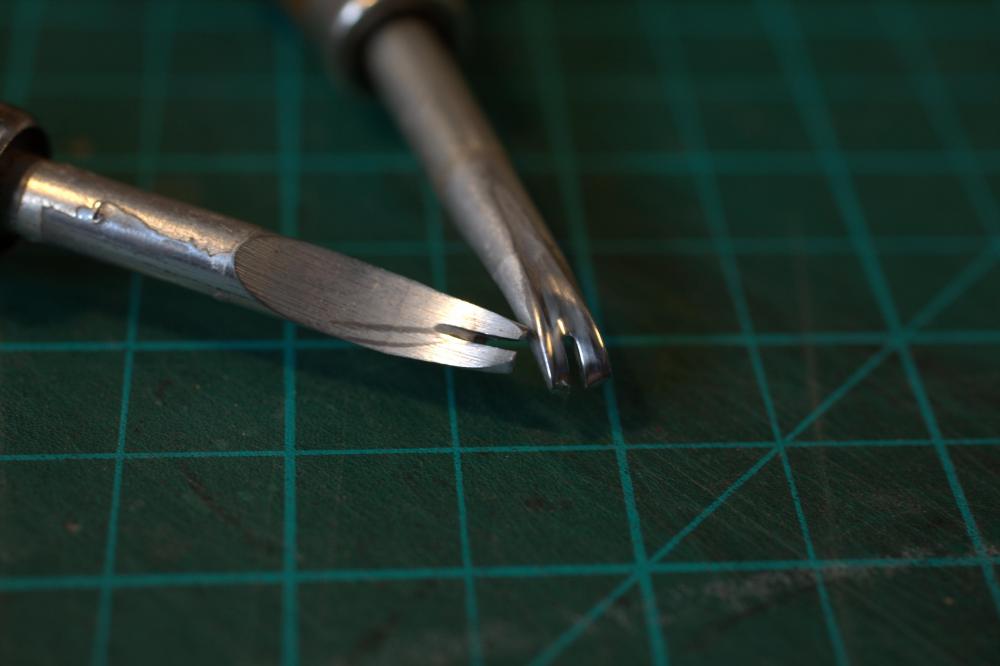-
Posts
10 -
Joined
-
Last visited
About Anvas
- Birthday 03/29/1967
Contact Methods
-
Website URL
www.celyfos.com
Profile Information
-
Gender
Male
-
Location
Athens, Greece
-
Interests
Music, Airplanes, Motorcycles
LW Info
-
Leatherwork Specialty
Cases, Holsters, Bags
-
Interested in learning about
Cases
Anvas's Achievements

Member (2/4)
-
File sent via message.
-
Hello there, I use some old edge tools an old craftsman once gave me. He told me back then these are CS Osborne. I am not sure as I see no logos on them. Only marked as No 1, 2, 3, 4 I have the whole series. Point is I want new ones. The same / Or something that works like these old ones. I use them to fine edging on thin leather 4 -5 oz I don't care if they are CS Osborne or something else Does anyone knows equivalent ? Advise needed !
-
I can send you over the file! I think Jim will have no problem with this. That was his intention from the first place. Sharing!
-
Servo motors are nice but can't substitute a skilled foot on a clutch motor's pedal. Even without any reducer pulley you can go stitch by stitch. It simply takes some decades and some hundred thousand miles of thread. And as my mentor said to me once when I was complaining on the motor's speed : "Learn how to sew first"
-
Always working with different projects at same time. Cut out all the pieces then dye them all, stitch ,etc. I have 4 benches. The main workshop bench with all my leather tools for finishing and small item's cutting . The second is one big "island" in the middle of the workshop for cutting the hides and dyeing- gluing. And finally two remote auxiliary benches for the dirty work, cutting wooden templates, and curing the molded or dyed parts. I found that small scale production of 5-10 items per time saves time and money and can be at very competitive prices. Rule of thumb : when I have a special order of an item I always make at least two more of them. And leave the options open for later. For example if it is to have bronze or nickel fittings I leave them without fittings till future customer decides. But then again I'm a lunatic and I do that professionally for only one year now.. :-) I'm fully equipped with full series of CS Osborne hand tools, 3 sewing machines, hydraulic clicker, a splitter machine, my own made edge burnisher, etc. thanks to all you guys and your precious advises, tips and deep knowledge in leather craft ! Greetings from Greece Andreas
-
Thanks Jim !
-
Thank you for your kind words! I involved into professional leather working 6 months ago.. I used to be an engineer and a hobbyist air-modeller. I'm fresh, so i still have the patients :-) This case is 28'' long. It roughly needed a half hide. Now I am working on a full carbon fiber shell case with suede lining.
-
Look, it depends on what you want to do with each machine. Sometimes I go the other way around... I get inspired of what every object is capable of doing and I go accordingly. For example I would never use a flatbed machine. But I just restored an Adler 104-102. . It's a flatbed 2 needle version of the 105 series which is commonly duplicated by junk Chinese clones. As previously mentioned by our friend Constabulary, the 2 needle machines do have limitations in accessory feet. But you can always modify some things if you have a technical idea and you find a blacksmith. Most important these 104 & 105 series can adjust the stitching length on the fly ! Meaning, that when you are stitching in tight curves you just lower the pitch and your result is an excellent evenly same stitching length look! Plus, you can use same big heavy duty thread sizes both sides, that even a leather worker can hardly tell which is a hand stitch or a machine stitch! I have a sample of a leather piece sewn both by hand and machine side by side as a test and I can upload it for fun :-) In your case I have an Adler 169 (the cylinder arm version of the 167) and I sew almost everything up to 10mm thick with great ease! I even sewn 6mm fiberglass composites + 2mm polyethylene + 3mm leather all together! 11 mm total !!! And because I am a big Adler fan, these old German machines can last almost for ever. In general, the older the machine, the better the build and the metal quality. In our times we lack the raw material quality and processing.. So, I would buy the Adler. Even if it needs a costly repair, it will last another lifetime of hard use. Find a specialized technician to help you with the machines you are interested in and God Speed !
-
Hi, For 5-6 mm leather just forget Adler 69... very reliable and solid machine, but not enough for leather that thick. Go for Adler 167 eyes closed, as long as it's in good condition without slack at the hook which costs about $400, or at the shaft... If you could find an Adler 169 which is the cylinder version of the flatbed 167 it would be a great choice. Don't be afraid of the high speed of the clutch motor. Soon you will learn to control it. Besides, for harness making a clutch motor running at 1200 rpm is ideal. It can run all day long. Just put some time practicing.
-
Hi, Just showing off my musical instrument (Greek lyra) case. Specs: - Shell material : Composites technology . Two layers of epoxy resin impregnated glass cloth with intermediate core / sandwich of expanded closed cell polyesterene. -Covered with Italian water resistant 1 mm leather. - The interior is lined with foam , in combination with synthetic wool felt - 3 Storage compartments with humidity absorbing crystals drawer made from 2mm aviation plywood /epoxy varnish finish. -Safety belt - binding instrument. The whole case works like a helmet . -Stainless steel hexagon bolts with locking nuts on all fittings. -Leather shoulder straps, padded. Well.... ok, this is not an entirely leather product.. there are also many imperfections on this case. This kind of cases are time and money consuming. The whole process takes me many days to complete... Greetings from Greece !













